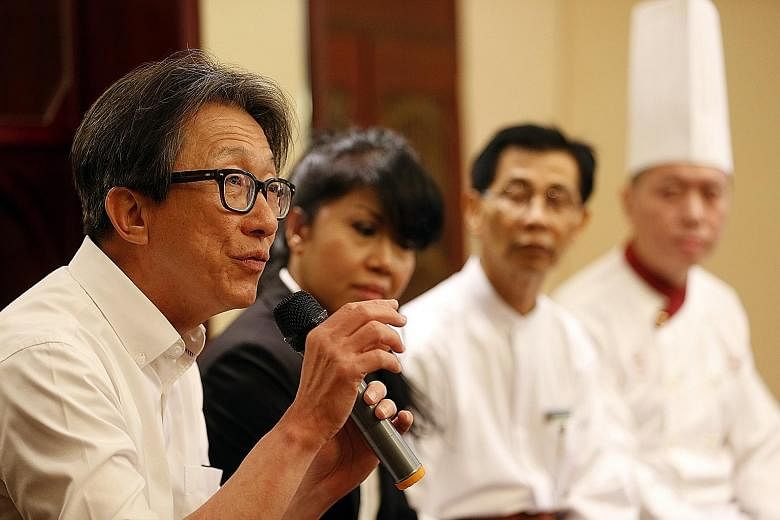Clearing tables was once very taxing for Mr Raymond Ong.
He had to make repeated trips to the kitchen because balancing a mound of trays was a tall order.
But since he joined restaurant Lawry's The Prime Rib two months ago, the 67-year-old has had a light trolley to collect dishes and cutlery.
"It makes it easier for me to work, which I want to keep doing as long as I am healthy, so that I am not a burden on my family," he said.
Mr Ong is the oldest of Lawry's 13 mature workers aged 50 and older, who form one-fifth of its staff. In 2013, it had just three such workers.
-
Guidelines on re-employment of older workers
-
From July next year, the re-employment age cap will be raised from 65 to 67. This means employers will have to offer eligible workers about to hit the retirement age of 62 the option to continue working till age 67.
Ahead of this change, a group of employer, worker and government representatives has updated the existing Tripartite Guidelines on the Re-employment of Older Employees. Key areas are highlighted here.
CONTRACTS AND ELIGIBILITY
•Employers should aim to re-employ most of their older workers. Contracts should be offered to all staff who are medically fit to continue working and whose performances are assessed satisfactory or better.
•Employers should engage staff on re-employment issues such as performance, pay and benefits as early as possible - not less than six months prior to re-employment - and offer contracts to eligible staff at least three months before retirement.
•To provide greater certainty, contracts should last five years, till workers turn 67. Or, workers could be on one-year contracts that are renewable up to 67, so long as they meet the eligibility criteria.
WAGES
•Reasonable adjustments to employment terms, including wages and benefits, may be made - but employers should consider the impact on the income of re-employed staff, particularly low-wage workers. Greater adjustments may be warranted for employees who previously held a larger or more senior job.
•If the worker is kept in the same job, wages can be adjusted down to the level of a younger employee with the requisite experience and competency for that same job, with the mid-point of the salary range of the job being a possible reference.
MEDICAL AND OTHER BENEFITS
•Employers can continue providing existing medical benefits. When costs are a concern, they can consider arrangements like co-payment of medical benefits or caps on claims.
•Employers can consider leveraging on MediShield Life- for example, by providing additional Medisave contributions for re-employed staff. This has the effect of making medical benefits more portable.
•Workers should not be required to serve the minimum qualifying period to be eligible for such benefits as annual and sick leave.
•Employers should, where appropriate, continue to reward re-employed staff based on company and individual performance in the form of performance bonuses, annual increments, long service benefits, gain-sharing incentives or one-off bonuses. This will help incentivise and motivate staff to perform well.
EMPLOYMENT ASSISTANCE PAYMENT (EAP)
•Employers should consider all available options to identify suitable jobs for eligible staff. If they are unable to offer re-employment, they should offer a one-off Employment Assistance Payment (EAP).
•The EAP amount could be 3.5 months of a worker's salary, with a minimum EAP quantum of $5,500. The EAP could be capped at $13,000 to moderate the burden on employers and prevent staff from being encouraged to stop working.
•The EAP should decrease over time as the worker approaches 67. Staff who have been employed for at least 30 months since age 62 could get a lower EAP of two months' pay, subject to a minimum of $3,500 and maximum of $7,500.
Manpower Minister Lim Swee Say commended Lawry's for being an "early adopter" of job redesign for older workers, ahead of legislation to raise the re-employment age from 65 to 67 in July next year.
Speaking to reporters after a visit to the restaurant yesterday, he said: "We are encouraged that more and more companies are, like Lawry's, aware of the importance, the need to make workplaces age-friendly."
But the awareness is not widespread enough, prompting Mr Lim to announcethe WorkPro scheme will be enhanced to better support job redesign for mature workers.
Starting from July this year, a company can apply for up to $300,000 in grants to fund job redesign projects targeted at workers aged 50 and older. The amount is twice the funding available previously.
Mr Lim said adopting better ways need not be grand measures. Just as valuable are "small ideas that mean a lot to mature workers".
Lawry's director Kevin Koh said the restaurant hopes to tap the enhanced WorkPro Job Redesign Grant to improve its e-menu system that allows its waiters and kitchen staff to use iPads to take and fulfil customers' orders.
The trial project has raised efficiency by 30 per cent, he estimated, and there are plans to improve it further to include age-friendly elements, such as a zoom function on the mobile devices for those who do not see too well.
Mr Koh, 45, said Lawry's struggled to fill vacancies in the past: "With this labour shortage, we realised we needed to tap these mature workers."
To make the work less physically strenuous on older employees, the restaurant has automated processes such as knife sharpening and dishwashing. Attendance is also taken with a fingerprint detector, to spare workers the need to remember to take their ID cards to work.
Lawry's offers flexible work schedules and has appointed younger staff as Silver Work Mentors, whom older workers can turn to for help.
Cook Patricia Leong, 60, said she appreciates the company for letting her take two weeks off during the Dragon Boat Festival to make some money fulfilling orders for dumplings from family and friends.
Labour MP Patrick Tay, NTUC's assistant secretary-general, gave a "loud call-out" to firms to redesign jobs for the aging workforce. His Facebook post follows yesterday's announcements of bigger grants for firms to redesign jobs, and recommendations for bosses to, among other things, give higher payouts to workers they cannot re-employ.
Said Mr Tay: "Workers (in particular low-wage workers) should not have their pay reduced when re-employed beyond 62, especially if they are still doing the same job with the same load."
He added: "Singapore as a society should also be more receptive and accepting of older workers."


